Kalanchoe thyrsiflora
Kalanchoe thyrsiflora Harv.
Family: Crassulaceae
Common names: white lady, bird’s brandy (Eng.); geelplakkie, meelplakkie, plakkie, voëlbrandewyn (Afr.); serilile (Southern Sotho); utshwala benyoni (Zulu); utywala bentaka (Xhosa)
Introduction
A striking addition to a succulent rockery or grassland garden, this plant stands tall with its striking white leaves and yellow flowers, at a time of the year when all the other plants are drying out for the harsh, dry winter months which lie ahead.
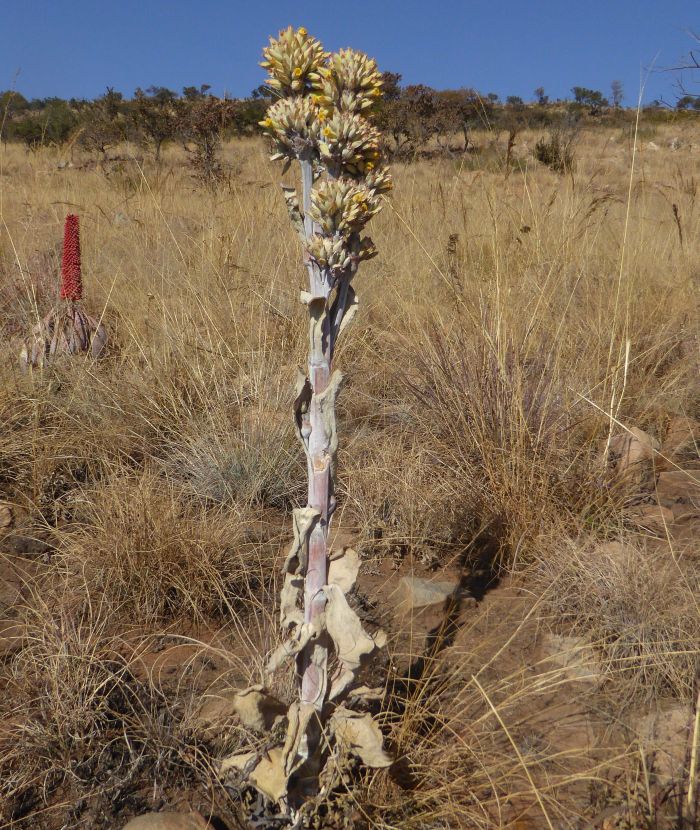
Description
Description
Kalanchoe thyrsiflora forms a basal rosette of large, whitish green, paddle-shaped, fleshy leaves, with somewhat reddish margins in the dry winter months. Plants stand about 0.8–1 m high at the end of the summer growing season, when they send up their elongated flower stalks to present the dense inflorescences, which are coated with a white powder. The basal leaves become progressively smaller as they ascend the main stem.
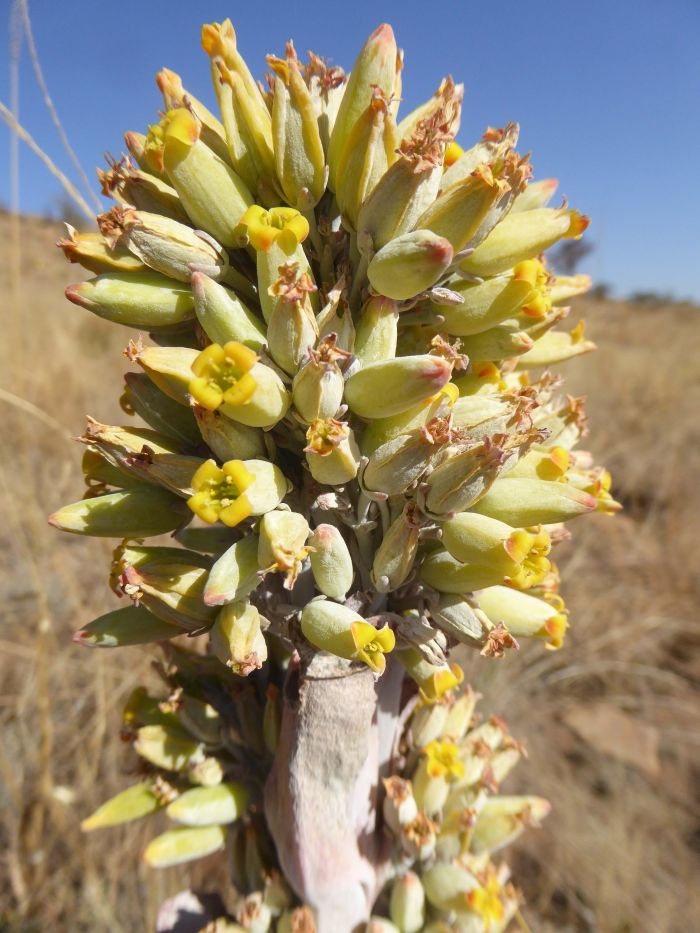
The compact inflorescence is comprised of many small, sweetly scented flowers that are whitish green on the outside, with recurved yellow petal lobes. The yellow is only visible on the inside of the petals of open flowers. Flowers are produced for an extended period from the end of the summer growing season into mid-winter (from February to June).
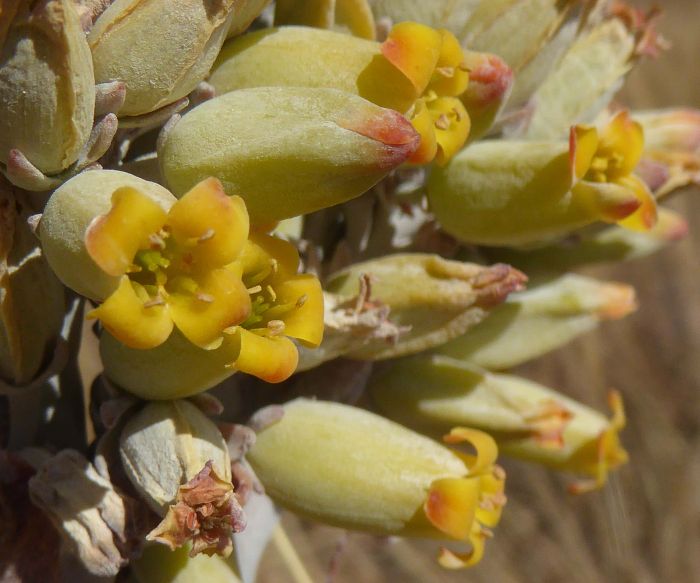
After flowering the plant gradually produces its seed before drying out and dying completely. Many thousands of dust-like seeds are produced and dispersed into the wind by the dead stalk, which persists after the plant dies. Although the main plant does die after flowering, it usually produces many small plantlets from the base, which can be removed and grown on to become new plants.
Conservation Status
Status
Least Concern (LC). Kalanchoe thyrsiflora is not threatened in its natural range.
Distribution and habitat
Distribution description
Kalanchoe thyrsiflora is found in the Provinces of Limpopo, North West, Gauteng, Mpumalanga, KwaZulu-Natal, Free State and the northern parts of the Eastern Cape, in South Africa. It is also found in Swaziland and Lesotho. This species prefers grassland and bushveld habitats, usually in rocky situations or exposed slopes and hilltops.
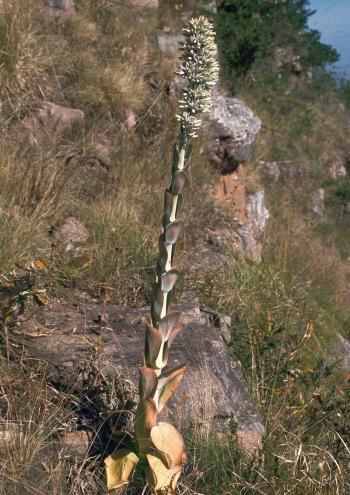
Derivation of name and historical aspects
History
Adanson, who derived the name from the Chinese epithet for one of the species, described the genus Kalanchoe in 1763. The species name thyrsiflora is composed of 2 words thyrsus, which describes the structure of the inflorescence that in botanical terminology is an elongate thyrse, and flora which means ‘to flower’, thus ‘flowers in a thyrse’.
The genus Kalanchoe is most abundant in Madagascar but also occurs throughout Africa, Cyprus, Indochina and Malaysia. It is a very well-known group and has become famous for certain attractive genera, species and cultivars.
Related genera native to South Africa include Cotyledon, Adromischus, Tylecodon and Crassula. The genus Kalanchoe is distinguished by its flowers, which have their parts in fours, the stamens being in 2 whorls of 4, whereas the ovary is comprised of 4 free pistils.

Ecology
Ecology
Kalanchoe thrysiflora occurs in areas which can be exposed to extreme conditions, ranging from very cold and dry with desiccating winds in winter, to hot spells in summer. Being succulent allows the plants to survive long periods of drought. Having a coating of white powder over the leaves and other parts, acts as a sun screen which further reduces moisture loss, thus aiding in keeping the plant cool. The white floury coating on the leaves and inflorescence, and their pale colour also helps to reflect the sun away and thus reduce the effect of heat build-up. The erect leaves are pointed upwards, towards the sun, in order to minimise the surface area that is exposed to the sun, thus assisting the plant to conserve moisture. Ants, bees and other flying insects, which visit the flower in the middle of the day, are responsible for pollinating Kalanchoe thrysiflora. The dried fertilized flowers may persist on the plants for a long time, and the very small dust-like seeds are dispersed by the wind.
Uses
Use
This plant is used in traditional medicine. The Sotho people use it as a charm to smooth away difficulties, and sometimes it is given in a medicine to pregnant women who don’t feel well. The Xhosa people use it to treat earache and colds. It is also used to make anthelmintic enemas. Please note that this plant is toxic to sheep and can have harmful effects on people, and should be used with caution.
Horticulturally this species is less popular than the commonly cultivated Kalanchoe luciae with which it is regularly confused, but they can be told apart as follows:
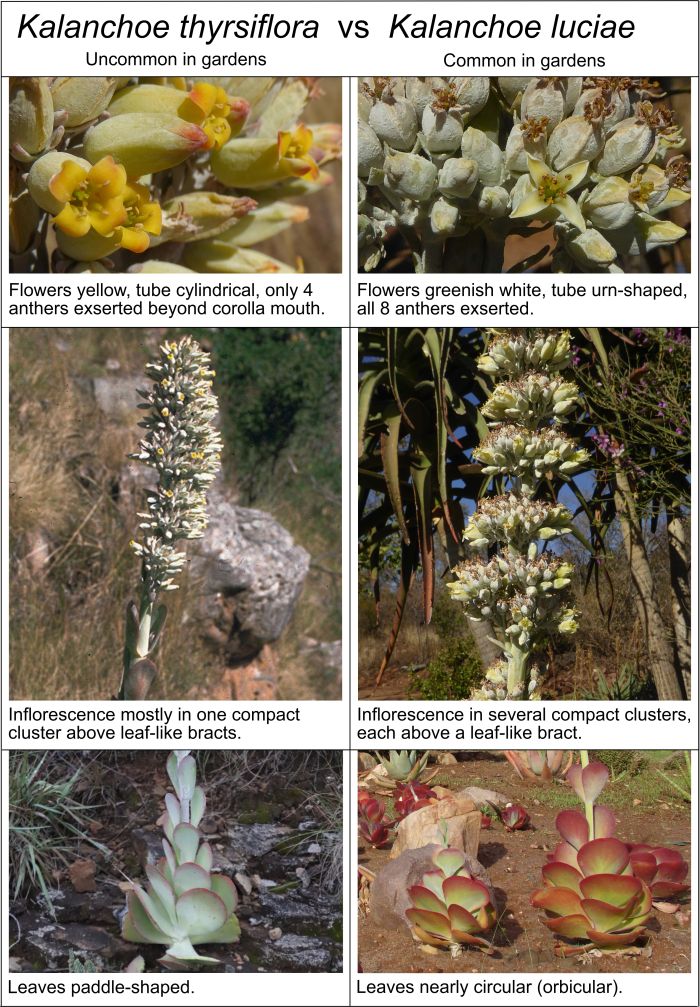
They make an excellent addition to succulent rockeries, on rocky outcrops, and as container plants. They can make a very striking display when planted en-masse. To bring out the best colour, the plants should be exposed to full sun and drought, as well as cool wintery nights. The plants can tolerate moderate to severe frost.
Growing Kalanchoe thyrsiflora
Grow
The fastest method of producing more plants is by collecting and sowing the fine, dust-like seeds. The seed can collected as soon as the capsules start to open. Collect the entire seed head and place it indoors on a sheet of white paper, out of the way of drafts or strong air movement. The fine seed will fall out as the seed head dries and collect on the white paper from where it can be cleaned and stored until ready to be sown. The seed should be sown in spring on a fine sandy-loam medium and not covered, the trays should be lightly misted and/or watered from below by placing the trays in a drip tray to allow water to be soaked up by the soil, and then removed and allowed to drain. Treat seed trays with a pre-emergence fungicide, as seedlings may suffer from fungal diseases that cause them to die rapidly after germination.
Vegetative propagation can be done by removing small plantlets that develop around the base of the mother plants (usually after flowering) or by taking leaf cuttings. These plantlets and cuttings can be rooted in coarse river sand. Place them in trays filled with coarse river sand in an area with good air movement and shade of about 40%. Plantlets and cuttings must be kept moist especially after roots appear, which normally occur quickly after the cuttings are taken. They can then be transplanted into larger containers until they are large enough to be planted out into the garden.
All kalanchoes respond well to commercial synthetic and organic fertilizers applied during the growing season.
Remember that these plants are from well-drained, rocky areas and prefer a similar garden habitat with plenty of direct sunlight in order to thrive.
References
- Germishuizen, G. & Meyer, N.L. (eds) 2003. Plants of southern Africa: an annotated checklist. Strelitzia 14. National Botanical Institute, Pretoria.
- Hutchings, A., Scott, A.H., Lewis, G. & Cunningham, A.B. 1996. Zulu medicinal plants: an inventory. University of Natal Press, Pietermaritzburg.
- Pole Evans, I.B. 1929. Kalanchoe thyrsiflora. Flowering Plants of South Africa. Vol. 9: pl. 341.
- Oliver, I.B. 1993. Grow succulents. Kirstenbosch Gardening Series, National Botanical Institute, Cape Town.
- Smith, G.F. & Figueiredo, E. 2018. Kalanchoe crouchii Gideon F.Sm. & Figueiredo (Crassulaceae), a new species from the dolomites of the Wolkberg Centre of Endemism, Mpumalanga Province, South Africa. Haseltonia 25:84-90.
- Toelken, H.R. 1985. Crassulaceae. Flora of Southern Africa 14: 1–229.
Credits
Andrew Hankey
Walter Sisulu National Botanical Garden
& Werner Voigt
Kirstenbosch National Botanical Garden
November 2019
Plant Attributes:
Plant Type: Succulent
SA Distribution: Eastern Cape, Free State, Gauteng, KwaZulu-Natal, Limpopo, Mpumalanga, North West
Soil type: Sandy, Loam
Flowering season: Late Summer, Autumn, Winter
PH: Acid, Neutral
Flower colour: Yellow
Aspect: Full Sun
Gardening skill: Easy
Special Features:
Horticultural zones











Rate this article
Article well written and informative
Rate this plant
Is this an interesting plant?
Login to add your Comment
Back to topNot registered yet? Click here to register.